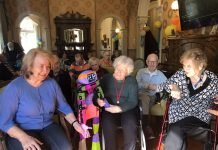New research will investigate how paramedics can actively support the preference of a large majority of Australians with life-limiting illnesses to die at home with their loved ones.
The HammondCare Foundation will financially support research that aims to assist the development of a national best practice clinical palliative care guideline to broaden the role of paramedics in delivering palliative and end-of-life care in Australian communities and reduce avoidable hospital admissions.
PhD candidate Madeleine Juhrmann (pictured), who has a background in paramedicine, will explore Australian and international literature on the topic, investigate current paramedic approaches to palliative care in community settings, and conduct a content analysis of each state and territory ambulance service’s relevant clinical practice guidelines.
Ms Juhrmann said paramedics are a unique workforce, attending to patients in their homes 24 hours a day in the case of medical emergencies.
The traditional scope of practice for paramedics has been limited to sustaining interventions for acute emergencies, usually involving hospital conveyance, rather than home-based care.
“General practitioners, community nurses and specialist palliative care services may not always be available to visit a palliative care patient at short notice as part of a rapid response to an emerging clinical situation, especially after hours,” Ms Juhrmann said.
“The default in this situation is to call an ambulance, more often than not resulting in the patient being transported to hospital.
“However, for people who have a progressive life-limiting condition, an acute hospital admission may not be wanted or the best setting to deliver palliative care.”
Recent research by the Grattan Instititute found 70 per cent of Australians want to die at home, but only 14 per cent currently have that wish granted. About 54 per cent die in hospitals and 32 per cent in residential aged care facilities.
As Australia’s population continues to age, the demand for palliative care services is increasing. According to the Australian Institute of Health and Welfare, hospitals saw a 19.2 per cent rise in palliative-care related hospitalisations between 2010 and 2015.
Ms Juhrmann’s research will be primarily supervised by Prof Josephine Clayton, Director of HammondCare’s Centre for Learning & Research in Palliative Care and Professor of Palliative Care at the University of Sydney.
Prof Clayton said: “As a palliative care physician servicing communities in various settings over many years, I can see the enormous value in this research to improve and compliment community palliative care in emergency situations.”
The four-year research project “Palliative Paramedicine: Broadening the Role of Paramedics Delivering Palliative and End-of-Life Care in the Australian Community”, is one of two PhDs supported by the HammondCare Foundation Postgraduate Research Scholarships.
Dr Graham Grove has also received funding for research on cultural and spiritual influences on euthanasia views in a changing world. His project will be supervised by Prof Melanie Lovell, Medical Head of Palliative Care, HammondCare Health.
HammondCare Head of Fundraising, Claire McCarthy, said the scholarships offered through the University of Sydney were the result of a generous donation received from The David & Judith Taylor Foundation.
“The donation supports innovative palliative care research and related research into cancer pain at HammondCare,” Ms McCarthy said. “On behalf of the HammondCare Foundation, I extend my heartfelt thanks for this generous gift to support our work to ensure best practice delivery in palliative care.”
The research complements HammondCare’s commitment to palliative care services offered through inpatient and outpatient settings in sub-acute hospitals, and through specialised services and programs in the community.











The ambos can have a great input to help people with terminal illnesses . This often will not take as much of their time when you look at the trip to a hospital and wait times to off load. Also moving people in palliative care stage of their illness is very uncomfortable and placing them in an environment they do not wish to be. The ambo have many skills and in today’s world with the use of technology should be able to quickly consult with a palliative care centre / GP and establish if the patient can be treated in their own home. Often reassurance is all that is needed by the person and their family. This journey is new to them and often very daunting. I have never allowed someone in hospital on my shift to die alone and if they can be at home with family and friends, all that is often needed is reassurance and emotional support and answers. Palliative care teams are not always the first call. Panic is to call an ambulance.
Hi, it is terrific to hear about this study… thanks for sharing it with us. One thing that might be worthwhile looking at is the comfort of the stretcher for people with advanced cancer.. my mother said that the worse thing for her while being transported to palliative care from home was the painful journey, she said she felt every little bump and it was excruciating due to her bony metastasis. Can there be an extra soft mattress option for these patients perhaps?
Thank you for all the work you are doing in this field..
HI
I have worked with (edited: A Canadian agency) providing palliative care in the patient’s homes for 16 years. There has certainly been some advances in palliative care over that time but none that have helped us care for the more and more people wishing to stay at home. One of our neighbouring communities Eastern Counties has recently established palliative support with their paramedics and we have already felt their support. This area is under-serviced to meet their increasing needs partly related to them living in a rural location. They have been able to help us keep patients at home and provide symptom management in between visit nurse visits. Examples were giving antiemetics and pain meds when they very quickly could access doctors orders. It would have left the patient with symptoms longer if we were limited to our visit nurse capacity and taking in to account the length of time we would need to access their own doctor for new orders. The families have very much appreciated the extra member to their community healthcare team.